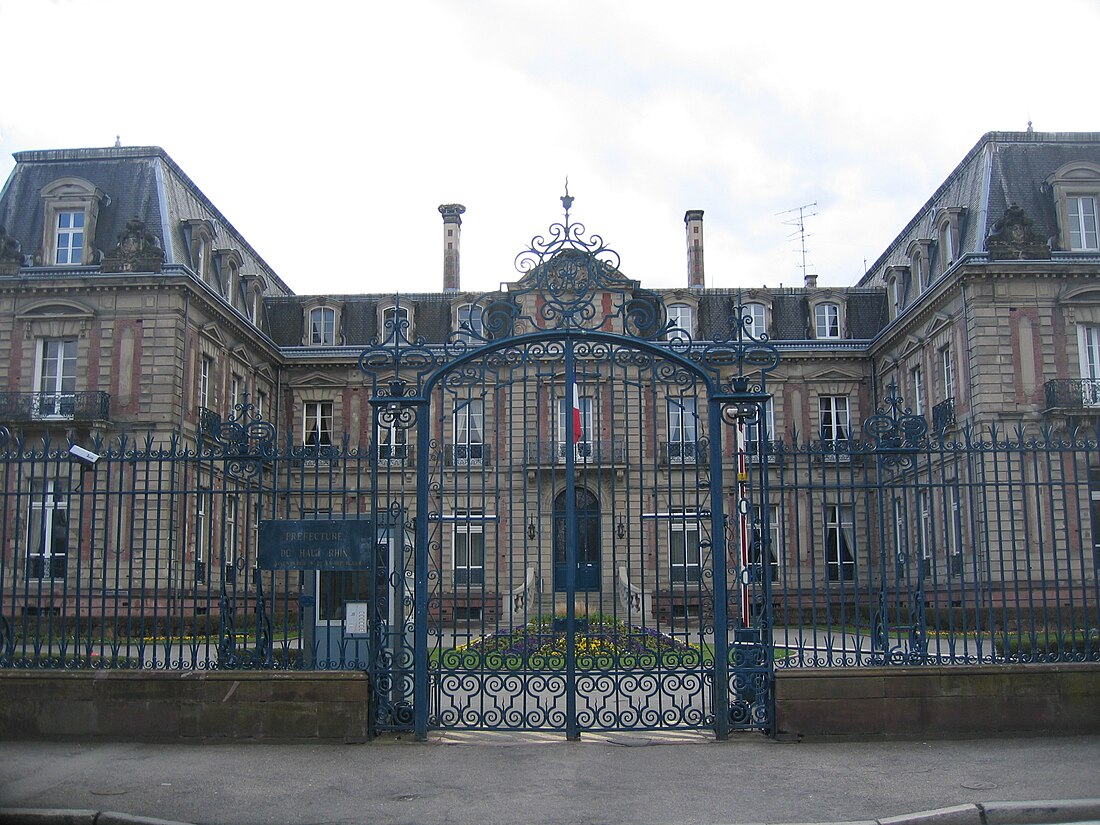Top Qs
Timeline
Chat
Perspective
Haut-Rhin
Department of France From Wikipedia, the free encyclopedia
Remove ads
Haut-Rhin (French pronunciation: [oʁɛ̃] ⓘ)[3] is a department in the Grand Est region, France, bordering both Germany and Switzerland. It is named after the river Rhine. Its name means Upper Rhine. Haut-Rhin is the smaller and less populated of the two departments of the former administrative Alsace region, the other being Bas-Rhin (Lower Rhine), especially after the 1871 cession of the southern territory known since 1922 as the Territoire de Belfort, although it is still rather densely populated compared to the rest of metropolitan France. It had a population of 767,083 in 2021.[4]
You can help expand this article with text translated from the corresponding article in French. (November 2009) Click [show] for important translation instructions.
|
On 1 January 2021, the départemental collectivities of Bas-Rhin and Haut-Rhin were merged into the European Collectivity of Alsace.
Remove ads
History
Haut-Rhin is one of the original 83 départements, created during the French Revolution, on 4 March 1790 through the application of the law of 22 December 1789 in respect of the southern half of the province of Alsace (Haute-Alsace).
Its boundaries have been modified many times:
- 1798, it absorbed Mulhouse, formerly a free city, and the last Swiss enclave in the south of Alsace;
- 1800, it absorbed the whole département of Mont-Terrible;
- 1814, it lost the territories which had been part of Mont-Terrible, which were returned to Switzerland, except for the former County of Montbéliard;
- 1816, it lost Montbéliard, which was transferred to the département of Doubs;
- 1871, it was mostly annexed by the German Empire (Treaty of Frankfurt); the remaining French part formed the Territoire de Belfort in 1922;
- 1919, it was reverted to France (Treaty of Versailles) but remains administratively separated from Belfort.
- 1940, it was annexed de facto by Nazi Germany.
- 1944, it was recovered by France.
Remove ads
Geography
Haut-Rhin is bordered by the Territoire de Belfort and Vosges départements and the Vosges Mountains to the west, the Bas-Rhin département to the North, Switzerland to the south and its eastern border with Germany is also the Rhine. In the centre of the département lies a fertile plain. The climate is semi-continental.
Subdivisions
The department consists of the following arrondissements:
Principal towns
The most populous commune is Mulhouse; the prefecture Colmar is the second-most populous. As of 2021, there are 11 communes with more than 10,000 inhabitants:[4]
Remove ads
Demographics
Population development between 1801 and 2016:
Economy
Haut-Rhin is one of the richest French départements. Mulhouse is the home of the Stellantis Mulhouse Plant automobile factory, where the Peugeot 2008 and Peugeot 508 are currently built. The lowest unemployment rate in France can be found in the Southern Sundgau region (approximately 2%). The countryside is marked by hills. Many Haut-Rhinois work in Switzerland, especially in the chemical industries of Basel, but commute from France where living costs are lower. However, the region does have some of France's worst socio-economic inequalities; Mulhouse has long been one of France's poorest major cities.
Remove ads
Law
Alsace and the adjacent Moselle department have a legal system slightly different from the rest of France. The statutes in question date from the period 1871–1919 when the area was part of the German Empire. With the return of Alsace-Lorraine to France by the Treaty of Versailles in 1919, Paris accepted that Alsace and Moselle should retain some local laws in respect of certain matters, especially with regard to hunting, economic life, local government relationships, health insurance and social rights. It includes notably the absence of any formal separation between church and state: several mainstream denominations of the Christian church benefit from state funding, in contrast to principles applied in the rest of France.
Remove ads
Politics
Presidential elections 2nd round
Current National Assembly Representatives
Remove ads
Tourism
- Mulhouse town hall
- View from the Ballon d'Alsace
Transport
The department's main airport is served by EuroAirport Basel Mulhouse Freiburg located in Saint-Louis, it provides air travel for the department as well as Basel-Stadt in the nearby border of Switzerland and Freiburg im Breisgau in Germany. Strasbourg Airport is another alternative airport that the department also uses, it is located 109 km (68 mi) north of Mulhouse.
Culture
See also
References
External links
Wikiwand - on
Seamless Wikipedia browsing. On steroids.
Remove ads









